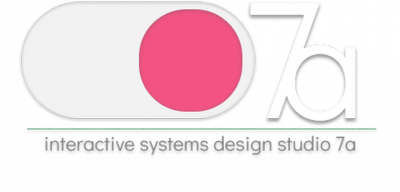
The course integrates student skills and knowledge from previous courses of the first stream of studies (Interactive Systems Design). The aim is engage students in dealing with an authentic project that involves external stakeholders, academics, customers, domain experts, end-users, etc.
The course runs with a suggested thematic area of application of interactive systems such as ‘smart home’, ‘cultural heritage’, teaching and learning’ etc. Students work in groups to:
- creatively apply methods and tools for empirical research, design and evaluation.
- design, experiment and prototype with interactive technologies.
- iterative develop solutions and evaluate them with end-users and other stakeholders.
- Creative use of methods and tools for empirical research and design and evaluation techniques that students have been taught in compulsory courses such as Human-Computer Interaction, Information Systems, Interaction Design, Cognitive Science.
- Application of interactive technologies students learned in other courses of the stream including Design for All, Digital Storytelling, Advanced Interaction Techniques and Applications, Design and Programming for the World Wide Web, Interaction Design.
- Based on Project based and Problem Based Learning, the course follows an iterative learning pattern of the application of research, design, prototyping, and evaluation.
The intended learning objectives of the course can be summarized as follows:
• Application of design methods related to an authentic context.
The main learning objective is to familiarize students with the application of design methods, techniques and tools, such as e.g. interviews, observation techniques, ethnographic studies. The aim is to train students on the basis of authentic problems in existing design frameworks. Students will gain experience in:
- conducting on-site observation of user activity in actual contexts where the users perform,
- designing the research protocol,
- identifing appropriate sources of information
- measuing user and context related data
- using and managing recording media,
- understanding requirements.
An important learning outcome is to understand the modeling and interpretation of research findings, while at the same time knowledge about the technologies involved is also considered important and is acquired through technological tests. Finally, students will gain experience in analyzing case studies and designing functional prototypes of applications in different fields such as entertainment, education, culture, etc.
• Prototyping of systems and applications with state-of-the-art interactive technologies
The main learning objectives during the prototyping phase are:
- students should be able to transform design requirements and specifications into creative design ideas and prototypes,
- students should be able to understand and use mainstream software tools,
- students should be able to implement software platforms and hardware technologies required for interaction programming,
- students should be able to develop and program simple prototypes of interactive systems, and finally
- students should be able to develop interactive prototypes using different technological tools and platforms such as Unity, Arduino, Raspberry Pi, Android Studio, etc.
• User centered evaluation of prototypes
The main learning objectives in the process of evaluating interactive prototypes are as follows.
- The students should be able to organise, plan and apply modern usability evaluation methodologies,
- The students should be able to compose and organize an evaluation plan, based on a specific design problem,
- The students should be able to select methods and tools according to the design objectives of the prototype.
An important learning objective is to master the organization and analysis of the collected evaluation data, as well as to compile a coherent and structured evaluation report that will thoroughly describe the problems of usability and user experience. Finally, the students should be able to propose design solutions for improving the overall design of the prototype in an iterative fashion.
- Albert, W., & Tullis, T. (2013). Measuring the user experience: collecting, analyzing, and presenting usability metrics. Newnes.
- Cooper, A., Reimann, R., & Cronin, D. (2007). About face 3: the essentials of interaction design. John Wiley & Sons.
- Goodman, E. Kuniavsky, M. Moed, A. (2012). Observing the user experience: a practitioner's guide to user research. Morgan kaufmann.
- Hanington, B., & Martin, B. (2012). Universal methods of design: 100 ways to research complex problems, develop innovative ideas, and design effective solutions. Rockport Publishers.
- Preece, J., Sharp, H., & Rogers, Y. (2015). Interaction Design-beyond human-computer interaction. John Wiley & Sons.
- Κουτσαμπάσης, Π. (2011) Αλληλεπίδραση Ανθρώπου-Υπολογιστή: Αρχές, Μέθοδοι και Παραδείγματα. Εκδόσεις Κλειδάριθμος.
- Κουτσαμπάσης, Π. (2015) Αξιολόγηση Διαδραστικών Συστημάτων με Επίκεντρο τον Χρήστη: Ευχρηστία, Προσβασιμότητα, Συνεργατική Εργασία και Εμπειρία του Χρήστη. Ελληνικός Σύνδεσμος Ακαδημαϊκών Βιβλιοθηκών. https://repository.kallipos.gr/handle/11419/2765
- Βοσινάκης Σπύρος (2015) Εικονικοί Κόσμοι: Σύγχρονες Προσεγγίσεις, Εφαρμογές και Ανάπτυξη σε Περιβάλλον OpenSimulator. Ελληνικά Ακαδημαϊκά Ηλεκτρονικά Συγγράμματα και Βοηθήματα.
Scientific Journals:
- ACM Transactions on Computer-Human Interaction (ACM).
- Behaviour and Information Technology (Taylor & Francis).
- Human–Computer Interaction (Taylor & Francis).
- Interacting with Computers (Elsevier; British Computer Society).
- International Journal of Human–Computer Interaction (Taylor & Francis).
- International Journal of Human–Computer Studies (Elsevier).
- Journal of Usability Studies (Usability Professionals’ Association).
- ACM Interactions (magazine, ACM).
- CoDesign: the International Journal of CoCreation in Design and the Arts (Taylor & Francis).
- Design Issues (MIT Press).
- Design Studies (Elsevier).


